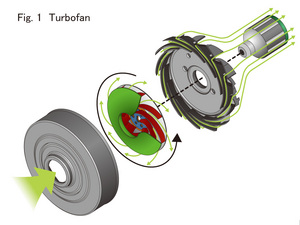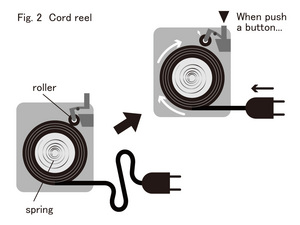Nagoya City Science Museum
TOP > Exhibition Guide > Keyword Search > Starting with "V" > vacuum cleaner > Vacuum Cleaner
Vacuum Cleaner



Purpose of Exhibition
Vacuum Cleaners are an indispensable part of our daily life. Although brooms had been used for cleaning tatami mats, vacuum cleaners have taken over and been continually improved to make the Japanese lifestyle more convenient ever since they were introduced to Japan from the U.S.. This exhibit is to demonstrate the mechanism of a vacuum cleaner which is familiar to all of us.
Additional Knowledge
[Motor and Fan]
Suction of a vacuum cleaner is caused by rotating a fan by means of a motor. The fan consists of several blades bound together between two metal plates. As the fan rotates, the air inside is pushed out and produces the flow of air. (Figure 1) This is a source of suction.
[Brushing]
It was difficult to vacuum the garbage and dust embedded deep in the fiber of the carpet. Thus, the idea of equipping a brush on the inlet of a vacuum cleaner and floating the garbage and dust up in the air by the rotation of this brush and making it easy to vacuum by rotating the brush, was adopted. It seems like there are different ways to rotate this brush, such as using a motor or a suction force produced when the cleaner vacuums the dust.
[Rewinding Coils]
The requirement that a cord should be extended long when in use and wound into the vacuum cleaner when not was achieved using the following mechanism.
Force for winding a cord is attributed to a plate spring. In order to use a vacuum cleaner, a cord is pulled. But a rubber roller holds onto the reel and fixes it in place, and obstructs the force for rewinding the cord with a plate spring.
When you push the rewinding button, the rubber roller comes off and it releases the force of plate spring. That is how the cord is rewound. (Figure 2, 3)
[Experiment of Vacuuming a Bowling Ball]
Have you experienced the powerful suction of vacuum cleaners? Here, you can see an experiment where a heavy bowling bowl gets vacuumed.
In the weight of a bowling ball, pound (lb*) is conventionally used. The bowling ball used in this experiment is 17 pounds (lb). Try calculating how many kilos this ball is. *1lb=0.45359237 kg
Cooperation:Hitachi, Ltd.
Article by Koichi Mabuchi, curator
